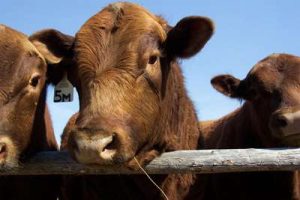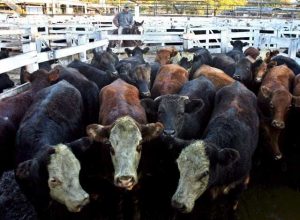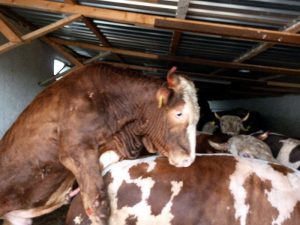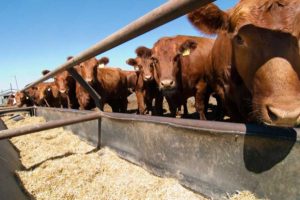Russ Rice a DVM from Broken Bow, Nebraska, writes in Bovine Veterinarian that a recent experience in a Nebraska feedlot, supported by extensive diagnostic work from veterinarians at the University of Nebraska-Lincoln, indicates Escherichia coli O165:H25, an enterohemorrhagic strain, can cause disease in cattle and potentially poses a food-safety hazard for humans.
 Nebraska veterinarians whose work on this case proved critical in establishing a diagnosis and analyzing the implications included Bruce Brodersen, DVM, PhD, Dee Griffin, DVM, MS, John D. Loy, DVM, PhD and Rodney A. Moxley, DVM, PhD.
Nebraska veterinarians whose work on this case proved critical in establishing a diagnosis and analyzing the implications included Bruce Brodersen, DVM, PhD, Dee Griffin, DVM, MS, John D. Loy, DVM, PhD and Rodney A. Moxley, DVM, PhD.
The case report was published in JMM Case Reports in November 2015, in an article titled “Haemorrhagic colitis associated with enterohaemorrhagic Escherichia coli O165:H25 infection in a yearling feedlot heifer.” Authors, in addition to Brodersen, Loy and Moxley, included Zachary R. Stromberg and Gentry L. Lewis from the University of Nebraska School of Veterinary Medicine and Biomedical Sciences, and Isha R. Patel and Jayanthi Gangiredla from the FDA’s Center for Food Safety and Applied Nutrition.
This case began in early January, 2014, with a pen of 170 Iowa-origin heifers, averaging 160 pounds, in a Nebraska feedlot. The 54 mega-calorie ration included dry and high moisture corn, 32% wet distillers’ grains, syrup, roughage, standard supplements and Bovatec.
In February, the feedlot crew began pulling some heifers from the pen for respiratory disease treatment. Crews noted that some bloody stools were present in the pen, and we treated the cattle with amprolium based on a presumptive diagnosis of coccidiosis. Bloody stools persisted though, and one animal died and another showed neurological signs and bloody diarrhea on February 18th. We euthanized that heifer using methods approved by the University of Nebraska Institutional Animal Care and Use Committee, and conducted a necropsy immediately. The gross lesion appeared to be acute inflammation of the cecum and colon. Our differential diagnosis included coccidiosis, salmonellosis, BVD, bovine coronavirus and clostridial enteritis.
We prepared fresh and fixed specimens and sent them to the UNL diagnostic laboratory for analysis. Dr. Loy’s laboratory isolated a strain of E. coli from the colonic mucosal tissue, and Dr. Brodersen noted histopathologic lesions in the colon that were suggestive of infection with a strain of attaching-and-effacing E. coli. He consulted with Dr. Moxley, an E. coli researcher, who requested the gross and fixed tissues for further study. Upon close examination, Dr. Moxley found small erosions in the colonic mucosa which he photographed. He then had his laboratory conduct other cultures, and had the original E. coli isolate serotyped. The isolate was determined to be an O165:H25 serotype. At this point, Dr. Moxley obtained specific antiserum to O165, and had the histology laboratory of the diagnostic lab conduct immunohistochemistry using this antiserum. Dr. Moxley found O165-positive bacteria in lesion sites corresponding to the gross erosions, and it was then that the cause of the lesions was confirmed. He had the isolate tested further by microarray analysis through collaborators at the FDA. It was found to contain virulence genes corresponding to type III secretion system (T3SS) structure and regulation. Microarray analysis of another E. coli strain (serotype O145:H28) isolated from the same tissue by the Moxley laboratory ruled the latter organism out as a pathogen in the case because that strain was found to have a number of mutations that inactivated virulence genes, such as those of the T3SS. Details of the molecular typing are included in the paper published in JMM Case Reports. …
The O165:H25 serotype is similar to E. coli O157:H7, and could be an emerging food-borne pathogen in cattle and beef. The pathogen has been isolated from the feces and beef carcasses of cattle, but has not previously been associated with disease in cattle. UNL scientists note that the serotype has been involved in uncommon, but potentially severe disease in humans. Based on findings in this case, we suggest veterinarians include enterohemorrhagic E. coli in their list of differential diagnoses when they see enteric disease, particularly bloody diarrhea, in feedlot cattle. If EHEC is suspected, veterinarians should work with their diagnostic laboratory to ensure proper collection, handling and submission of appropriate samples for diagnosis.
At the diagnostic laboratory, Drs. Moxley, Brodersen, and Loy indicate that these lesions might not have been seen in samples taken as early as ten minutes of death. Fortunately in this case, in which we euthanized the heifer and were able to collect samples immediately, we were able to verify this unexpected diagnosis. Most of the time, post-mortem changes will occur before we get the opportunity to collect samples.
Several veterinarians have commented to me they may have missed cases of EHEC in the past. I probably have missed these as well. Going forward, I plan to take extra care in collecting samples and communicating this to our clients. This case serves as a good reminder of the public-health risk we face on a daily basis. We all need to emphasize this to our clients and staff.
 To summarize demographic, clinical, and antimicrobial drug resistance characteristics of human infections with this organism in the United States, we analyzed data for 1968–2013 from 5 US surveillance systems.
To summarize demographic, clinical, and antimicrobial drug resistance characteristics of human infections with this organism in the United States, we analyzed data for 1968–2013 from 5 US surveillance systems. 








